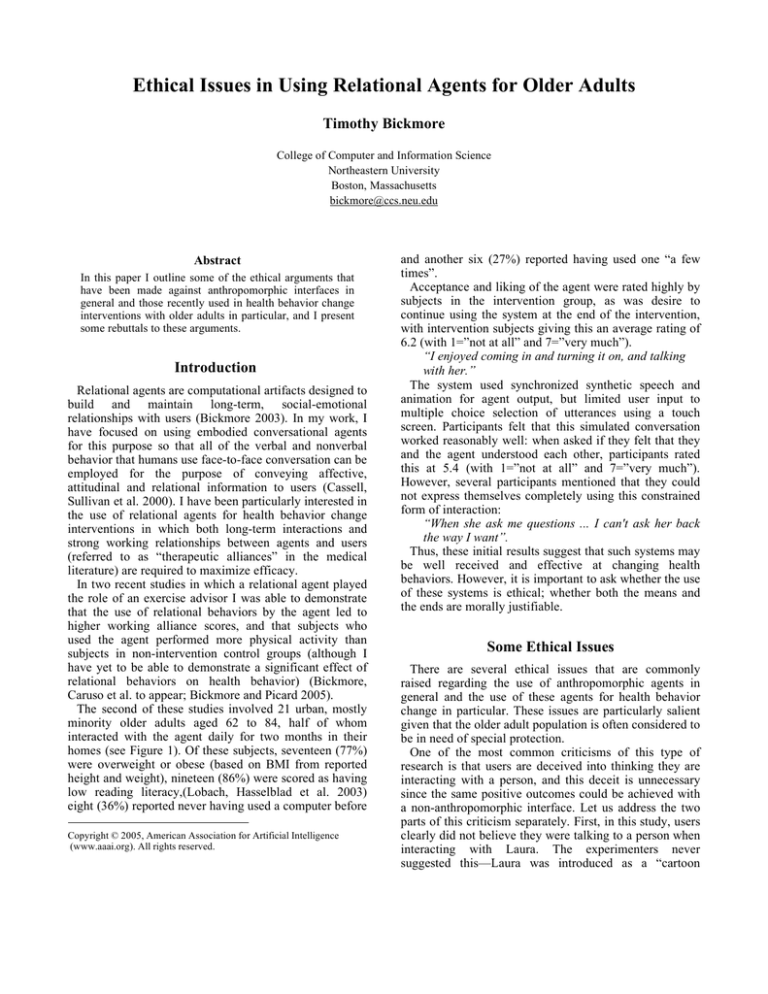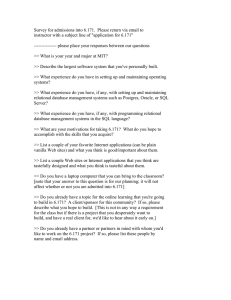
Ethical Issues in Using Relational Agents for Older Adults
Timothy Bickmore
College of Computer and Information Science
Northeastern University
Boston, Massachusetts
bickmore@ccs.neu.edu
Abstract
In this paper I outline some of the ethical arguments that
have been made against anthropomorphic interfaces in
general and those recently used in health behavior change
interventions with older adults in particular, and I present
some rebuttals to these arguments.
Introduction1
Relational agents are computational artifacts designed to
build and maintain long-term, social-emotional
relationships with users (Bickmore 2003). In my work, I
have focused on using embodied conversational agents
for this purpose so that all of the verbal and nonverbal
behavior that humans use face-to-face conversation can be
employed for the purpose of conveying affective,
attitudinal and relational information to users (Cassell,
Sullivan et al. 2000). I have been particularly interested in
the use of relational agents for health behavior change
interventions in which both long-term interactions and
strong working relationships between agents and users
(referred to as “therapeutic alliances” in the medical
literature) are required to maximize efficacy.
In two recent studies in which a relational agent played
the role of an exercise advisor I was able to demonstrate
that the use of relational behaviors by the agent led to
higher working alliance scores, and that subjects who
used the agent performed more physical activity than
subjects in non-intervention control groups (although I
have yet to be able to demonstrate a significant effect of
relational behaviors on health behavior) (Bickmore,
Caruso et al. to appear; Bickmore and Picard 2005).
The second of these studies involved 21 urban, mostly
minority older adults aged 62 to 84, half of whom
interacted with the agent daily for two months in their
homes (see Figure 1). Of these subjects, seventeen (77%)
were overweight or obese (based on BMI from reported
height and weight), nineteen (86%) were scored as having
low reading literacy,(Lobach, Hasselblad et al. 2003)
eight (36%) reported never having used a computer before
Copyright © 2005, American Association for Artificial Intelligence
(www.aaai.org). All rights reserved.
and another six (27%) reported having used one “a few
times”.
Acceptance and liking of the agent were rated highly by
subjects in the intervention group, as was desire to
continue using the system at the end of the intervention,
with intervention subjects giving this an average rating of
6.2 (with 1=”not at all” and 7=”very much”).
“I enjoyed coming in and turning it on, and talking
with her.”
The system used synchronized synthetic speech and
animation for agent output, but limited user input to
multiple choice selection of utterances using a touch
screen. Participants felt that this simulated conversation
worked reasonably well: when asked if they felt that they
and the agent understood each other, participants rated
this at 5.4 (with 1=”not at all” and 7=”very much”).
However, several participants mentioned that they could
not express themselves completely using this constrained
form of interaction:
“When she ask me questions ... I can't ask her back
the way I want”.
Thus, these initial results suggest that such systems may
be well received and effective at changing health
behaviors. However, it is important to ask whether the use
of these systems is ethical; whether both the means and
the ends are morally justifiable.
Some Ethical Issues
There are several ethical issues that are commonly
raised regarding the use of anthropomorphic agents in
general and the use of these agents for health behavior
change in particular. These issues are particularly salient
given that the older adult population is often considered to
be in need of special protection.
One of the most common criticisms of this type of
research is that users are deceived into thinking they are
interacting with a person, and this deceit is unnecessary
since the same positive outcomes could be achieved with
a non-anthropomorphic interface. Let us address the two
parts of this criticism separately. First, in this study, users
clearly did not believe they were talking to a person when
interacting with Laura. The experimenters never
suggested this—Laura was introduced as a “cartoon
Figure 1. Relational Agent Interface was Accepted by Older Adults
character”—and Laura also periodically reminded
subjects that she was “just a computer character with
limited capabilities.” Subjects—with the exception of a
few moments of forgetting—classified her somewhere
between a machine and a person. Next, the contention that
the same effects could be achieved with a conventional
(non-relational) interface has a significant amount of
evidence against it, at least for helping applications such
as the one presented here, given the many studies that
have shown the importance of working alliance, empathy
and patient-centered communication for maximizing
outcomes in long-term helping situations. These behaviors
require some elements of an anthropomorphic interface to
implement, including at least language and at most some
form of body for nonverbal behavior. As with any
interface comparison, however, this is ultimately an
empirical question requiring a formal study to contrast the
two
specific
interfaces—anthropomorphic
and
conventional—in question.
Other criticisms of agent-based interfaces have been
made by Lanier and Shneiderman. Lanier is concerned
that autonomous agents “dumb us down” by restricting
our range of expressivity and action (Lanier 1995). There
is some truth to this concern given the current interface
modality that restricts users to multiple-choice selection
of pre-written conversational utterances. However, one of
my research goals is to find ways to allow the user greater
expressivity while not raising expectations about the
system’s functionality. In my opinion, presenting users
with an unconstrained speech or free text input capability
when the system can only respond in a small number of
ways in a given context is itself deceitful. Shneiderman’s
criticisms are that anthropomorphic interfaces undermine
predictability and consistency (leading to increased user
anxiety), and that they have been a commercial failure
(Shneiderman 1995; Shneiderman 1997). Regarding
Shneiderman’s concerns, I feel that an embodied
conversational interface can actually enhance users’
perceptions of predictability and consistency by providing
a single interface modality across a wide range of
functions, and which leverages their pre-existing
knowledge and skills (i.e., of how to conduct face-to-face
conversation) as much as possible. If anything, the users
wanted more variability and novelty in the interface, not
less. Perhaps the reason that anthropomorphic interfaces
have not been a commercial success is that they have
been repeatedly used in applications in which efficiency
and accuracy are the most important requirements (e.g., as
in banking machines). In one of Shneiderman’s critiques
of anthropomorphic interfaces, he states that they are
“cute the first time, silly the second time, and an annoying
distraction the third time” (Shneiderman 1995).
Interestingly, I have found exactly the opposite to be true
in my studies for most users, even though contact with the
agent did tend to taper off over time.
I would also argue that helping and psychotherapeutic
applications such as the one presented here require the
use of natural language in order to understand as much as
possible about users’ thoughts, feelings and behavior and
to deliver appropriately tailored interventions, and that as
soon as an interface uses natural language in any form
(including text) it is, in effect, an anthropomorphic
interface subject to all of the criticisms described above.
One cannot present an utterance to a user (even brief text
messages) without them making judgments about the
personality, interpersonal attitude, relational stance and
emotional state of the agent delivering the message (see
Reeves & Nass for several examples (Reeves and Nass
1996)). Thus it is impossible to build a non-trivial system
for this kind of application that is not anthropomorphic.
The ethics of deploying technology to change user
behavior (‘programming the user’) is another area of
concern. I argue that the issues here are no different than
those faced by a human helper who is interested in
changing a client’s health behavior. The system can be
said to be respecting the user’s autonomy as long as: 1)
the user is free to decide whether to use the system or not;
2) the user is free to decide whether to follow the system’s
recommendations or not; 3) the role of the system is
primarily to provide information to enable the user to
make informed choices; and 4) appropriate amounts of
persuasion are used by the system only in cases in which
the user is clearly making an unhealthy decision
(O'Connell and Price 1983). Regarding this last point,
while it is true that human helpers may be more
understanding and adaptive than an agent (for now at
least), the agent follows rules that are open to inspection
and validation, and follows them in a consistent and
unbiased manner, something that cannot always be said of
human helpers.
Finally, I think that the results speak for themselves. Not
only did the study involving older adults demonstrate
significantly more walking behavior in the relational
agent group, but I also found that all subjects enjoyed the
overall experience and most enjoyed interacting with
Laura on an ongoing basis. As the most vocal critic of
Laura put it:
“It was the best thing that happened to me, to
have something that pushed me out and get me
walking.”
Certainly from a utilitarian ethical framework at least,
this kind of intervention is well justified.
Conclusion
Based on my experience with older adults, I believe that
the caring, social, anthropomorphic interface enabled the
exercise promotion system to be readily accepted, usable
with minimal training, and effective in achieving a
desired behavioral outcome with this user population.
While the potential for misuse certainly exists (as with all
tools), the potential for achieving beneficial outcomes has
been demonstrated and represents a promising direction
for future research.
Acknowledgements
Thanks to Jennifer Smith, Rosalind Picard, Ramesh
Farzanfar, Jeffrey Mignault, and Robert Friedman for
their many helpful comments on this article.
References
Bickmore, T. 2003. Relational Agents: Effecting Change
through Human-Computer Relationships. Media
Arts & Sciences. Cambridge, MA, MIT.
Bickmore, T., L. Caruso, et al.to appear. "It's just like you
talk to a friend" - Relational Agents for Older
Adults. Interacting with Computers.
Bickmore, T. and R. Picard. 2005. Establishing and
Maintaining
Long-Term
Human-Computer
Relationships. ACM Transactions on Computer
Human Interaction 12(2): 293-327.
Cassell, J., J. Sullivan, et al., Eds. 2000. Embodied
Conversational Agents. Cambridge, MA, The
MIT Press.
Lanier, J. 1995. Agents of Alienation. Interactions of the
ACM 2(3): 66-72.
Lobach, D., V. Hasselblad, et al. 2003. Evaluation of a
Tool to Categorize Patients by Reading Literacy
and Computer Skill to Facilitate the ComputerAdministered
Patient
Interview.
AMIA,
Washington, DC.
O'Connell, J. and J. Price. 1983. Ethical Theories for
Promoting Health Through Behavioral Change. J
of School Health 53(8): 476-479.
Reeves, B. and C. Nass. 1996. The Media Equation.
Cambridge, Cambridge University Press.
Shneiderman, B. 1995. Looking for the bright side of user
interface agents. interactions 2(1): 13-15.
Shneiderman, B. 1997. Direct manipulation for
comprehensible, predictable and controllable
user interfaces. International Conference on
Intelligent User Interfaces, Orlando, FL.




